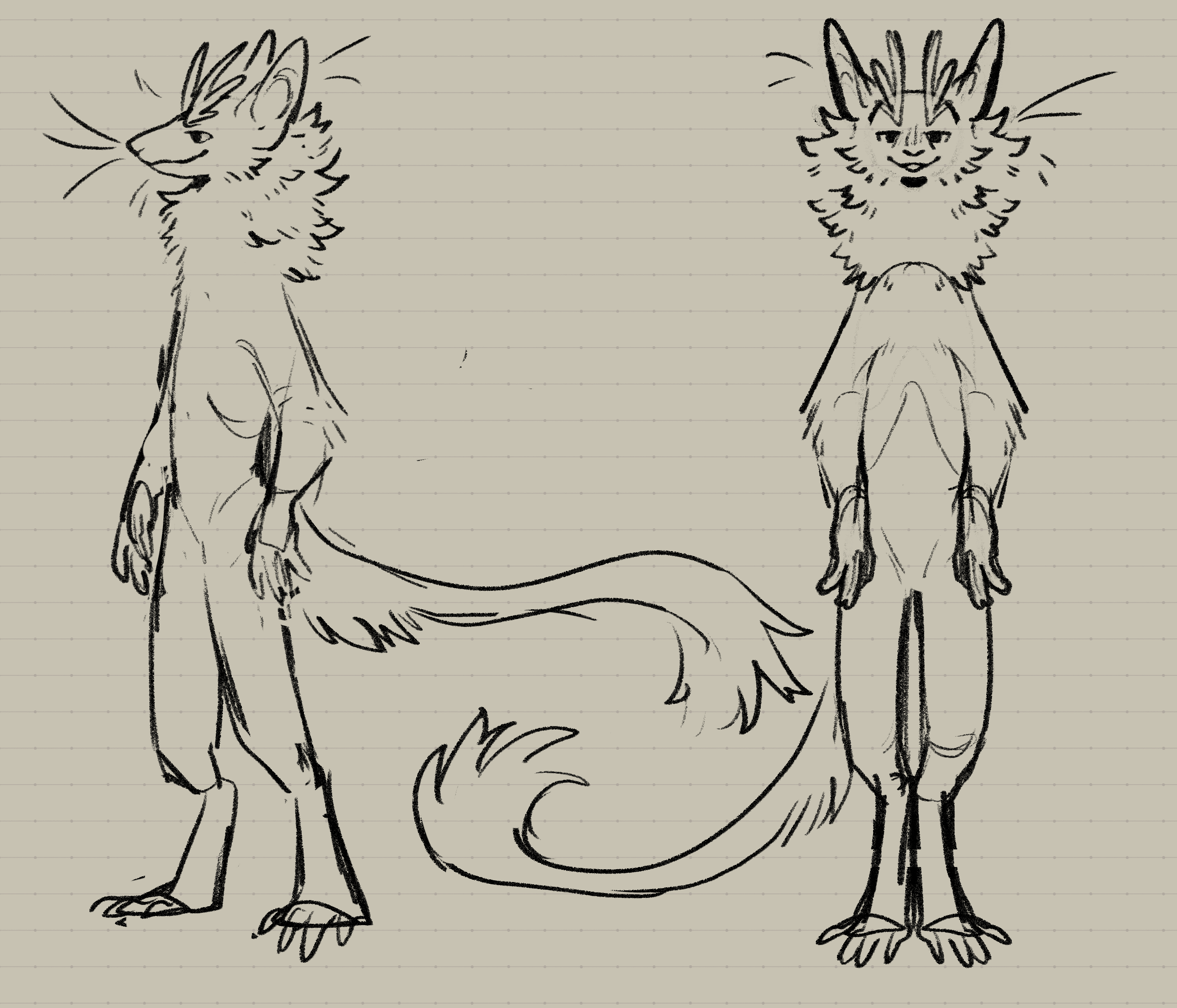
Luminae are a semi-fossorial (subterranean) species, having settlements both in the surface and underground, originated from cerrados, but expanding into most expansive valley-like biomes such as savannas and prairies. They're a small-sized biped with thick antennae sprouting above their eyes. They are furred, the thickness and texture of fur ranging from short to long, straight to curly, with their tails and necks' being longer than the rest of the body on average. However, they can also be fur less.
Their feet are long, and can swap from to plantigrade, though digitigrade is the most common locomotion method. They have long, dexterous fingers which can grow large claws made for digging. and thick padding underneath They're great at living in packed and darker spaces, being extremely flexible and a natural sense of direction and space. They are omnivores, with a wide diet ranging from fruits, nuts, insects, larger meat, fish and roots. They will also consume rocks for additional mineral sources.
Physiology Notes
Head
Luminae have a wide range of head structures. On average, they have an elongated, somewhat sharp snout with a flat head. However, prominent foreheads and blunt, short snouts are also present due to minor Aether Tampering. They have long whiskers sprouting from their muzzle, chin and upper head, with tactile functions and being part of their expressions.
Antennae
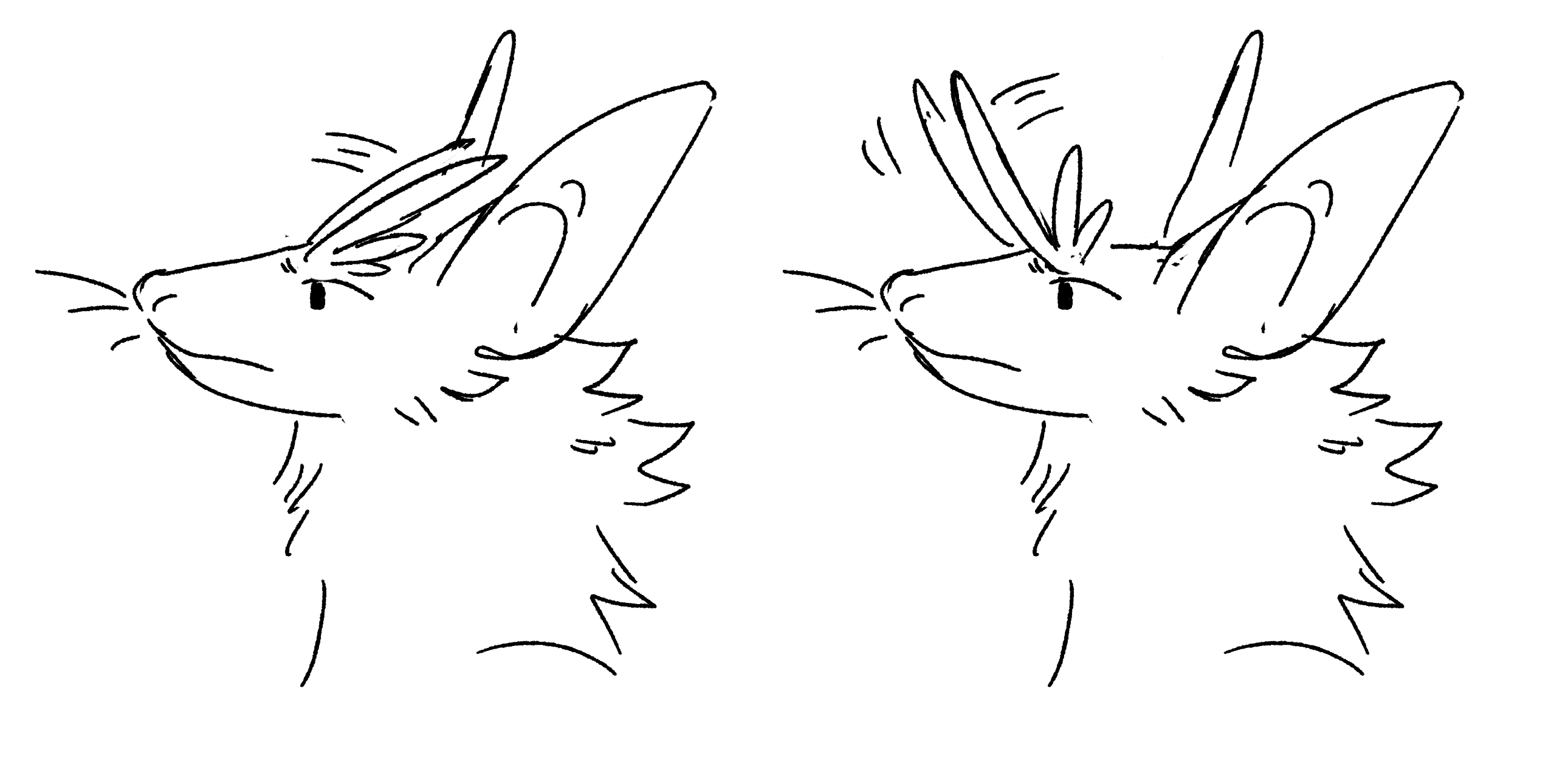
The flexibility range of antennae.
Antennae are external organs, with 2 to 3 branches rooted above the eyelids. They are stiffer and thicker than whiskers but still have some degree of mobility, sweeping back and forth. Their main purposes are to sense air motion, capture light and identify local pressure. These functions help Luminae locate themselves in dark underground areas, the direction of exits and flow of air in a settlement, and warn themselves of faults in the rock and possible cave ins.
Luminae are born with the antennae root, but it only starts growing around teenage years, leaving pups vulnerable to getting lost. Their length varies, though shorter antennae are less efficient. Less sensitive than whiskers, antennae are sensitive nonetheless, and clippings, piercings or even obstructing with articles of clothing can cause pain and distress. Not only that, but antennae will repair themselves and grow back, leaving any modifications hard to maintain.
Eyes & Ears
Luminae have excellent vision, adapted to low light and bright environments. They can see all colors in the visible-eye spectrum, though they are unable to sense ultraviolet or infrared. Their eyes can have different shapes and colors, but the effect is purely visual as their eye membranes work the same regardless of their appearance.

Left: A collection of some eye shapes and patterns found in Luminae.
Right: Luminae eyes are reflective, and shine when light is pointed at them, especially in low light.
The external ears of a Luminae are heavily affected by Aether tampering. The common ear is large with a triangular shape, but many develop different styles such as short, elongated, circular, square, etc. Because of the variety, it is very common to style and modify ears further, with piercings, clippings and accessories. It takes a while for the cartilage to regenerate, leaving these styles as semi-permanent.
The internal structure remains the same, as such the outer ear can only impact hearing up to a certain point, as the inner and middle ear will not capture and process sound they're not designed for. This gives them good hearing, being better at listening to higher frequency than lower frequency, and otherwise have standard ranges and ability to distinguish sounds and small individual variation in what they're better at picking up.

Top: An example of observable ear styles in Luminae. Flop and droopy ears are a common effect of weak cartilage.
Bottom: Asymmetry in ears can manifest as mismatched ear types, scarring and manual styling: ear cuts, accessories, etc.
Mouth

A diagram of the inside of a Luminae's mouth, and an individual using a dental chewing stick.
Luminae have 36 teeth, with a front row of long incisors, four canines, sharp premolars and flat molars. Their dentition is crafted for their omnivorous diet, allowing them to tear through meat, break nuts and shells, and grind down plant matter such as leaves and fruit. Their bite is not overly powerful, but it can still tear skin and cause damage. Their teeth never stop growing, and must be worn down. Luminae will often grind their teeth in rocks or dental chewy sticks as part of their dental care, otherwise their teeth can become overgrown and cause issues.
They have short, triangular tongues with small barbs for grooming. Their taste buds are sensitive, and they have an easier time discerning sweet flavors than others. They have a small tolerance to spice, and a greater tolerance to bitterness. Their mouth, just like most of their organs, tends to take the most prominent color of their Aether.
Nose
Their nose is a triangular shape with two cavities separated by cartilage. Their cavities can expand in size and capture more air when inhaling, an adaptation to the thinner air inside tunnels and limited airflow. Their lung capacity is large with more efficient filtering systems.
They have an excellent olfactory system, being able to smell pheromones and scent trails, allowing them to discern fauna and flora farther away. They can identify other individuals by their smell and, as each Luminae has an unique odor, with family and friends creating a longer lasting imprint.
Body

A small glimpse at the range of Luminae body types.
Luminae size and builds are diverse, with fat, muscle mass and height based on lifestyles and genes. Underweight Luminae are rare, as their average body mass is already light and further loss can bring sickness and several health issues. Their proportions stay consistent, with arms, legs and torso being around the same size and medium necks, but deviations aren't uncommon.
Limbs

Luminae hands, with filled and grown nail sizes.
Luminae shoulders are placed right below the neck, with their hands resting around their hips. What they lack in strength they have in endurance, built to dig and climb through tunnels and caves. Their fingers are long and dexterous, capable of minute control with tools. Their claws can grow long and impede their ability to hold things, but modern Luminae will file down their nails often as most settlements are dug out and maintained with tools and machines instead..
They have medium size legs, with thighs longer than their feet. They're fast, reaching 30 km/h running speed and 55 km/h sprinting speed, which can only be maintained in bursts of a few minutes. They can also hop while running, using the momentum to reach farther than normal running. They can swap into a plantigrade stance, which is a lot more stable but loses a lot of speed and is considered "baby walk" by most adults.

Left: A Luminae in plantigrade stance.
Right: Arms get tucked in when running.
Tail
Luminae tails range from medium-long, and typically will have longer fur than the rest of the body, a trait shared with the neck. However, fur less and short furred tails are not uncommon. Hairless tails show the structure underneath: long, slender and highly mobile. Some individuals may have thicker tails due to fats or muscle, but they will always appear lithe proportionally.
Their main function is to serve as a balancing limb, keeping them stable when walking and helping with turning and control when running at fast speeds. Longer tails can have a rudimentary ability to grab things, though only effective on objects that are lightweight and easy to hold.
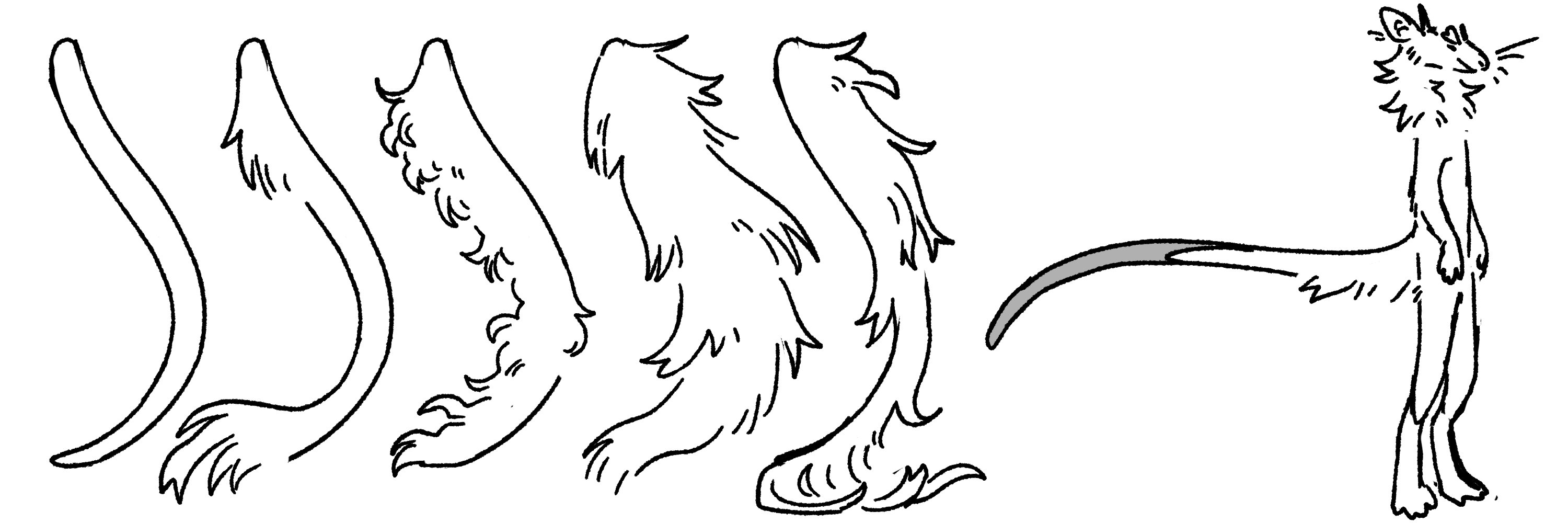
Left: A small sample of fur styles for tails. Usually matches the rest of the body, but not always. Naked tails are common in certain regions.
Right: Minimum tail size compared to maximum tail size (in grey).
Aether
The natural Aether of Luminae is Igazo Aether. This helps them with lighting up underground paths and making travelling at night easier, combined with other adaptations to the dark. Most cast their Aether through their necks or tails, but refined and precise use will use their hands instead.
Aether Shedding
Luminae bodies never stop producing Aether. This can cause issues as excess Aether that isn't given function can become volatile and cause internal damage. To combat this, all leftover Aether moves to their Aether glands to be used for casting, and once those are full the Aether is automatically expelled from their bodies. The frequency of their shedding can vary depending on the user, from once a week to constant.
Visually, it appears as an atmospheric effect around their necks and tail, corresponding to their Aether. This shed Aether is weaker than normal and can have little to no physical effects to the Luminae or others around. There is no consistent appearance to these effects, but the following are the most common:
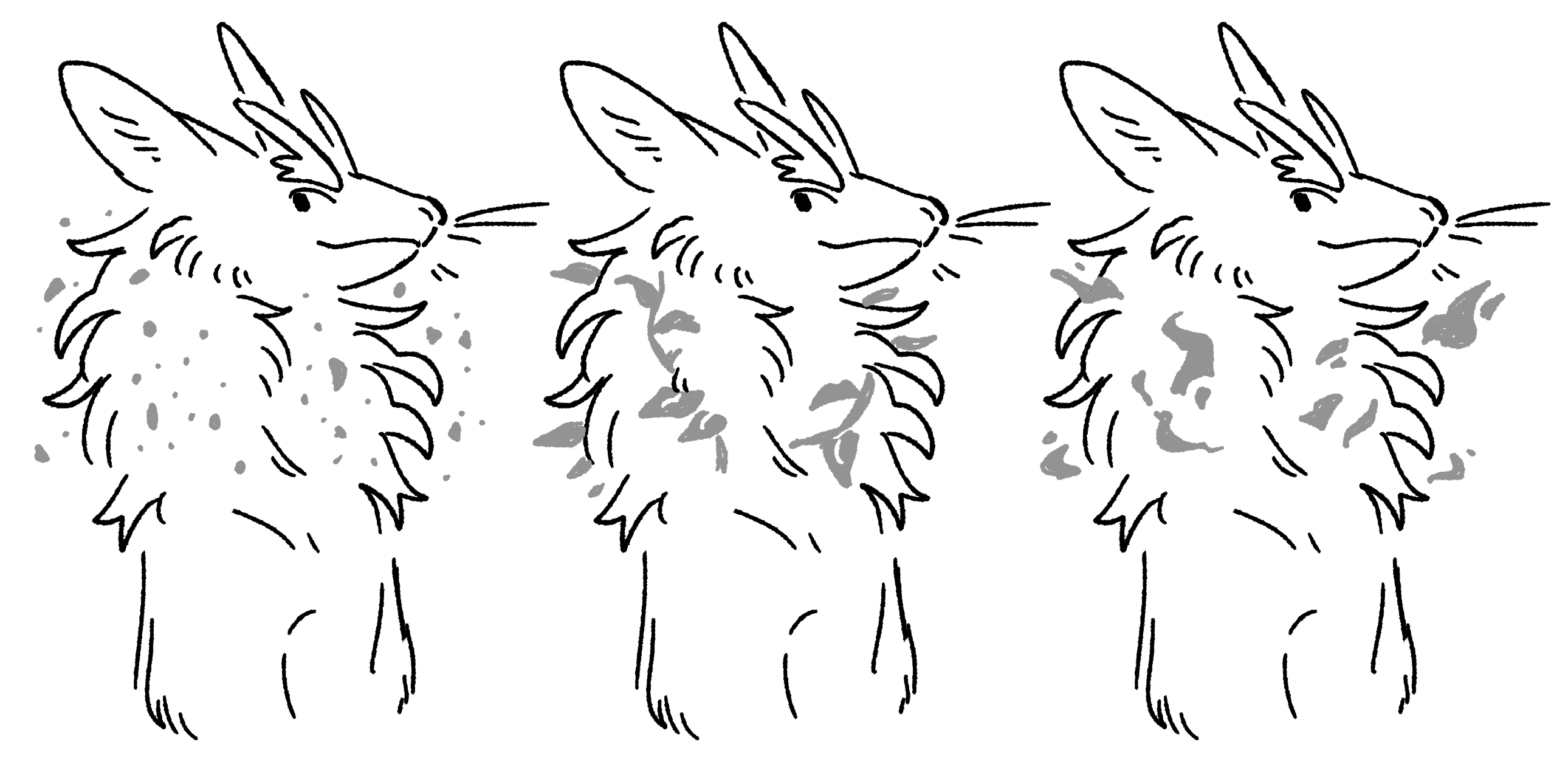
Aether shedding on an individual with Igazo, Kusho and Ignis Aether respectively.
Gako
Tumuna
Ignis
Hibus
Tocha
Aes
Tocha
Gero
Kusho
Donuma
Kinru
Saisei
Igazo
Sadem
Biira
Jitium
Reproduction
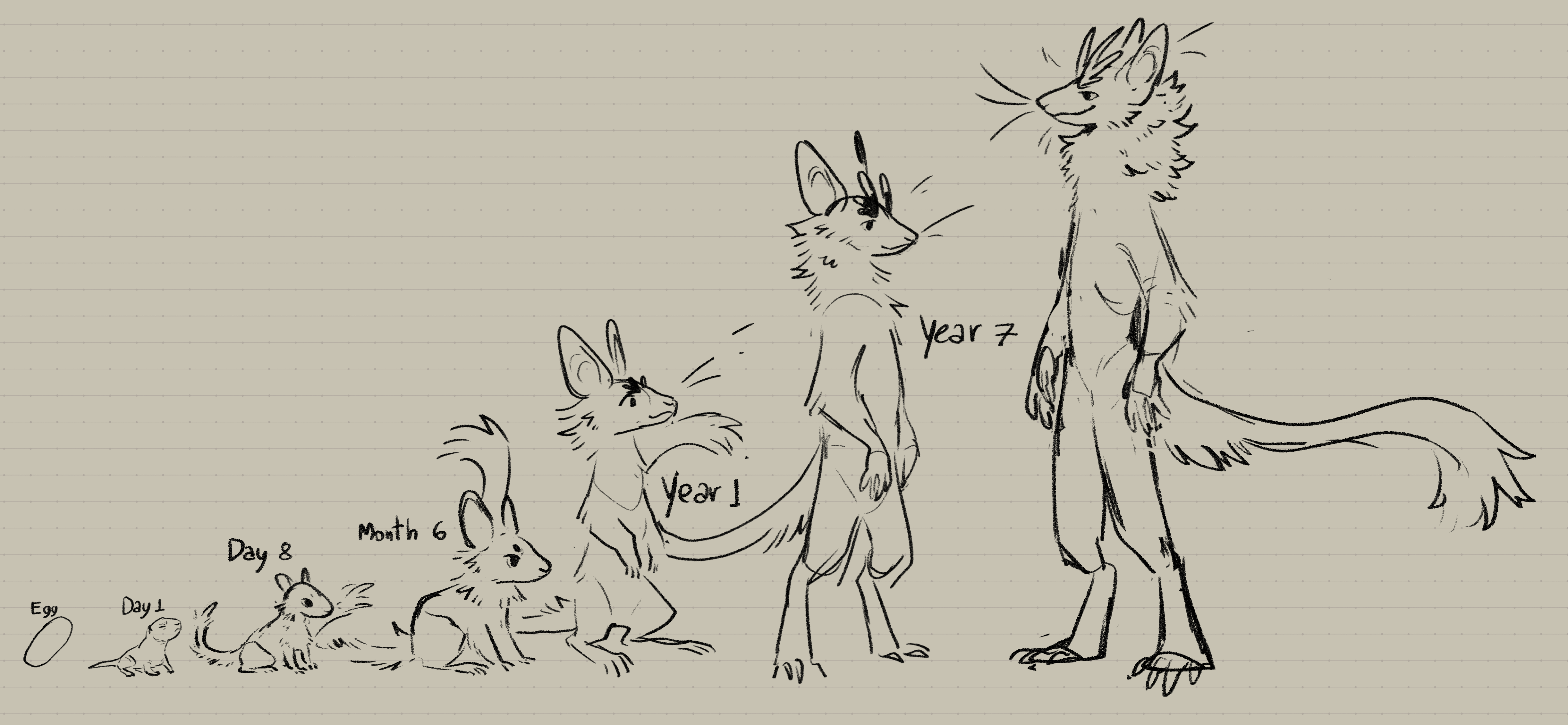
The development cycle of a Luminae, to scale.
Egg
Luminae are a trisex species, with the default sex being infertile and changing into one of the reproductive sexes when first reproducing, depending on their role in the family. This change reverses after reproduction, and one Luminae may swap roles various times during their life.
To create an egg two individuals will sexually reproduce, with lustre for the parent laying the egg and vulto for the sire. While they can attempt to reproduce anytime, attempts are more successful in their breeding months, going from 8% to 35%. On average, one Luminae will produce 2-6 eggs per breeding. Unwanted eggs are eaten by the lustre or discarded, though discarding eggs is not a common practice as seen as wasteful
After reproduction, the egg will take around two weeks to develop and after laying will continue development for two more weeks. It has a soft shell that quickly hardens after contact with air, protecting the embryo. Near the hatching date, the baby will start eating the shell and eclode once the walls become brittle.
Amor
Once they hatch, babies are called amor and will be called that until adulthood. They're born small and underdeveloped, often kept in nests or carried around by parents in their neck fur or clothing. By day 8, amors will have opened their eyes and started growing fur, and they'll grow into their toddler proportions. After one year, they'll reach the toddler stage, characterized by resembling more of an adult Luminae. Their antennae start sprouting around this age, but Aether shedding will not start until near adulthood. Toddlers still have a mainly plantigrade walk and will walk on fours until they develop stronger muscles for digitigrade walking and longer legs. They have the maturity of a 5 year old at that stage.
By their 7th year they'll start walking digitigrade, and begin a teenager stage of development. Their antennae fully grow and they reach their final height at around 10 years old. They'll reach adulthood at 13 years old, no longer an amor but a full adult.
Arts
Visual arts
- The earliest known artistic creations from Luminae have been drawings inside their tunnels, depicting family members, fauna and flora and other untranslated scripts. As their communities grew, cave painting became more and more elaborate, with colors being harvested and added to create colorful and intricate patterns.
- In modern societies, wall painting and graffiti are extremely popular. Tunnels are public spaces and thus anyone is allowed to paint in the walls, though established groups have been known to create rivalries and paint over each others’ symbols and patterns. Similarly, families will paint their house's tunnel and cave walls, the colors and markings often being their family crests or motifs.
- Artisans will often create pieces with straw and other plants. Tubarro plants are sturdy and resistant to burning, which makes them easy to manipulate and then fire in kilns, to harden them and increase their longevity. Clay sculptures are also popular, with toys, charms, and decorations being the main creations.
Literature
- Luminae literature's greatest classics come from novels, romantic and otherwise. Common trends are obfuscation, nuanced stories and inconclusive endings, with debates on certain characters and finales being very popular to this day. Plot twists, unexpected turns and long narratives are recurring themes. Other common genres are political dramas and suspense horror.
- Pure heroes are rare to see in Luminae stories, as most characters are morally grey or of dubious and untold morality. Authors rarely position themselves on how their characters should be viewed, and authorial commentary is seen as overprotective, squashing the possibility of good debates.
- Narratives rarely involve grandeur and world-changing events, instead often focused on a specific city, a certain tunnel block, a few families and their interpersonal issues.
- The prose itself tends to be very ornate. "Purple prose" is not an issue in Luminae writing, and readers are encouraged to engage and enjoy the extravagance fully. Seeing where it goes and what it means is part of experience.
- Non-fiction often focuses on the documentation of family groups and drama surrounding them, or broader topics such as political bureaucracy and discovering paper trails. Even in these accounts, it's not uncommon for a focus on more dramatic events and the author’s own flavor of writing to seep into an otherwise faithful retelling.
Architecture
- Luminae live in large underground tunnels and caves connected to the surface, with different architectural structures developing for each space’s needs.
- Underground structures are less so built but rather dug into the proper size and dimensions for what the building needs, which is often various smaller cave rooms connected by mini tunnels and walkways, then decorated as needed. These buildings are then connected by an entrance tunnel into the main tunnel road.
- For houses, the first room is a semi-public room where goods, packages, invitations and other items can be dropped and individuals can ask to meet with a resident. It's common for one of the building members to be tasked with taking care of this room, greeting guests and writing down messages and transactions. This role has been dying off with digital log screens being used instead.
- On the surface, large clay huts with tunnels connecting to an underground basement room are the most common structure, meant to keep the building cooled from the heat. Most buildings are a single floor, but multiple floors are connected with spiral tunnels. This makes their shape look cylindrical and thick. Sometimes, the basement will be directly connected to the underground city, though some are only accessible from the surface.
Transportation
- Luminae underground cities are very wide, so they have a mix of domesticated travel animals -- Azan-ge-Gampa (or Rock-that-trots transliterated) being the most popular. These large, cockroach-like burrowing beasts are docile in nature and can carry multiple Luminae and goods on their backs when used as mounts, or can otherwise be strapped to cargo. There are also buses attached to tunnel rails.
- On the surface, mounts dominate transit and long distance travels, though with connections to Hanasei's railways advancing, Luminae are making use of these more often.
Clothing
- Fabric is made from silk of farmed underground cattle similar to moth larvae and caterpillars.
- Looser styles are the most popular, protecting from wind currents on the surface and dirt underground. Long garment pieces, often covering below the neck and similar to ponchos are commonly seen; these may also have front openings and work like capes with ornaments at the end.
- Cloth may also be tied and used to carry items and young Luminae. Traditionally, these worked as a simple large bag and could be tied and untied in any form, but modern styles come with woven pockets and chambers and tie in one specific spot.
- Another popular piece of apparel is a large shirt with long sleeves, tucked inside an ornamental sash on the waist or below the chest - often embroidered.
- Garments for legs are less popular. It's more common for cloth to fall down to legs or feet, either coming from a sash, a large poncho or shirt, etc.
- Tail veils are found in festive and religious outfits. Jewelry bands with hooks are worn on the bottom of the tail, connecting the veil's two ends to form an arc; different configurations have more or less veil arcs.
- Tassels are found in almost all types of clothing. There are various styles of tassel, some having religious or symbolic meaning and others being purely decorative. Some styles are almost exclusively used by certain groups and may showcase their family's position in society. Other embellishments are medals, encrusted gems, beads and metal finishes, but these don't have as much importance as tassels.
Music
- Most Luminae music is high energy with sharp and energetic lyrics, catering to various types of dances and festivals. Criticisms of other families, jobs, and society in general get sprinkled in most songs, even if that is not their main theme. String and percussion -- especially idiophones, instruments that create sound by vibration such as scrapers -- are very popular.
- Many songs include mentions of deities in both reverence and mockery, challenging or thanking them depending on the context. Music made for religious rituals is more respectful and methodical, but often keeps the high tempo of most Luminae works.
- Slower songs exist, empathizing melancholy, sadness and death. Wind instruments, such as flutes and free reeds similar to harmonicas can be featured here very often, though not exclusively.
Cuisine
- Luminae cuisine includes a lot of arthropods and plants that can be found and cultivated underground. Farming is the main way to acquire protein, with derivatives such as edible silk, milk and eggs. Luminae communities rarely hunt, and seafood is rarely if ever found.
- Edible silk is processed into cheese-y strings (although the taste is very different), or boiled into a base ingredient for baked goods and soups. Eggs are cracked and grilled or cooked, and milk is used as an ingredient similarly to edible silk.
- Meats are grilled and left medium rare on average. The blood is often stored and made into candies or added as a flavor enhancer in other foods.
- Farmed plants are tubers and roots, with leaves also being eaten. Very few plants bear edible fruits where Luminae come from, so fruits are classified as an import, rare desserts to enjoy.
- Seeds can be found in many dishes, but the most popular ones are Usserina seeds, which can be ground down into a nice, sweet-tasting powder. Many desserts are made with it.
Language
To be written.
Writing Script
To be written.
Names
- Given name: Amores' names are extremely simple, often two or three syllables that have no meaning. Repeating sounds are very popular. Examples: Baba, Pepepa, Milili, Jeje
Once they become adults, they'll receive a new name that matches their personality, work and expectations. Names are often corruptions of real words, as naming someone directly after a creature or object is considered disrespectful to the creature/object itself. - Middle name: A fusion of both parents’ names. The name fusion will be picked by them, and there are no rules on which syllables or order they follow, allowing for various new combinations.
- Last names: Family name, which is shared by all members of the family. These names often come from jobs or places that a family could be associated with, permutated with time.
- Sounds: CH, CR, BR, L, J, M and N sounds. RR, LH in the middles, M, R and L endings. Many vowels in every syllable spot, diphthongs and triphtongs.
Uncommon sounds are QU, GU, GR and Z.
Examples: Chaua, Lerrim, Mamalhoa, Aleoja, Alecriam, Orrivel
Society
- Luminae have a very communal way of living. They organize themselves in family units, where multiple generations will live in the same house, and it's rare for a Luminae to leave their family unit other than marriage, being kicked out or aging and moving to an elder house.
- Two types of family units exist: The most common are trader families, where every member will work in the same area of expertise, sometimes having the same job. One or two members may be allowed to branch off depending on the family's needs. Mixed families have members who work in different trades and places, and are often made up of Luminae who left their original families due to conflicts with the family business or needs. Rarely, a trader family will be made of mostly non-related members who all come together to work in the same business.
- Families will often have a pecking order related to age and perceived capability. Luminae who lag behind will be relegated to chores and "unskilled labor", similar to a domestic worker. Younger members will also participate in learning chores and how to take care of the house before being allowed to pursue higher education. Higher members of the pecking order will still participate in chores after work, especially in larger families who need many things organized, and families where there are very few houseworkers may simply hire instead.
Age
- Luminae babies develop fast. By their first year, amores are put in educational courses -- grades spanning around 3 months -- and taught house chores. In trader families, education often comes from within the house on the families' particular roles, goals and rules, in addition to graduating classes. Most of their time is spent exploring their future roles and playing.
- Around teenage years they begin settling on their chosen role and start taking specialized courses, becoming more involved with family business and affairs. Indecisiveness at this age is frowned upon as childish.
- Young adults will be fully settled in and start acquiring a job, either in family business or in other workplaces. Adulthood is where Luminae start exploring beyond their family’s bubble and start learning about the cities and tunnels proper.
- Elders will retire and often be the highest in the house pecking order, organizing each member’s work of the day and managing finances, food and other needs. Elders who can no longer perform any work will often move to elder houses, where they're taken care of by workers and accommodated for. They are rarely left alone for long, however, as one of the family members will often visit and update them with the weekly family logs.
Customs and Celebrations
- The first Aether shedding marks the transition from an amor to an adult, usually at the age of 13. The family will often celebrate with a large party, inviting friends of the new adult. Guests and family members must give gifts, and food and drinks are provided for the day. On the day after, they'll be taken by an older member to explore the city, its businesses, and go beyond the family's reach for the first time.
- At the peak of the rainy season, a festival will happen entirely on the surface, celebrating the lower temperatures and thanking the saint of rain at the peak of their power.
Politics
- Families are focused over individuals in politics: Votes, issues and proposals are made per family instead of per individual. Not all members may agree with each others’ politics, but it's common to compromise, and the higher ranks get their way more often. Political clashes are becoming a common reason for leaving a family house.
- Similarly, most politicians are in families with the entire family's work revolving around politics of their chosen side. Political families are the most common trader family unit where its members are often not related -- akin to joining political parties, but even more involved, as family rules and expectations still exist.
- Individuals who join politics often become honorary family members of a party, instead of acting individually.
- With many bodies involved in managing cities, squabbles and conflicts happen frequently, and laws go into testing stages before being implemented, which gives time for opposing families and voters to discuss them. Some families have higher influence than others, and politics often mimic the pecking orders found in families onto the family houses themselves.
- Political information takes a long time to leave the political family bubble, with much of it kept confidential or redacted. Average families can be kept out of the loop for years.
Religion & Beliefs
- Luminae communities technically have one main religion -- Nanango -- but the number of variations and regional differences brings the argument of separating versions from each other. There are no central authorities or organizations for Nanango; rather, each community will have their own Gin -- a building for prayer and communal festivities, and thus their own particularities.
- Other religions also exist, though they are less popular and some are at risk of going into extinction. Nanango-centric communities do not discriminate against other religions, but the lack of accommodation leads to many fading away into obscurity.
Nanango
- Nanango is a polytheist religion, created when Luminae families started organizing into larger communities and local religions mixed with each other. It easily incorporates new deities and beliefs onto itself, which lead to many smaller religions being absorbed into it and losing their individual believers.
- The main Nanango gods are Ilhanda-ge-Eraes (Light that Gleams), Noavelo-Matera (Protecting Darkness), Liquenche-ta-So (Water of Skies) and Esbara-to-Mostra (Belly of the Beast), representing the sun, darkness, rain and drought. The hierarchy of each deity depends on the Nanango branch, with some viewing them as equals and others putting some at higher importance than others. They are often depicted as their abstract representations instead of having any concrete form, Luminae or otherwise.
- While the main pantheon doesn't change often, the smaller deities and saints vary heavily, and are not always revered or seen positively. A branch may view a smaller deity with high respect, while another will mock and curse it.
- Nanango is a heavily animist religion, and many of its deities come from or are themselves objects or natural concepts. Aether is connected to this view, as Aether is viewed as a life blood; since everything in Koegama contains Aether, everything has life blood running through it and thus is alive.
Folklore
To be written.